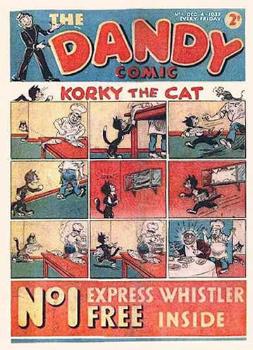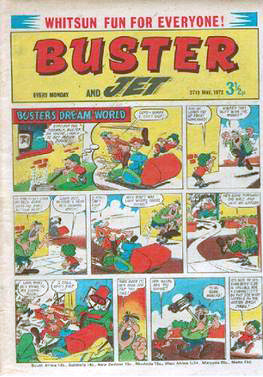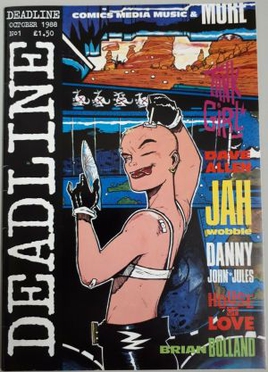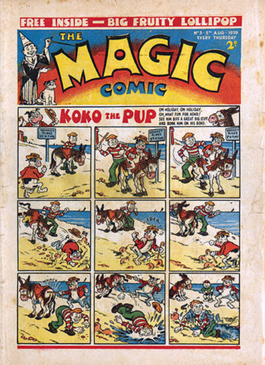
The Bash Street Kids is a comic strip in the British comic magazine The Beano. It also appeared briefly in The Wizard as series of prose stories in 1955. The strip, created by Leo Baxendale as When the Bell Rings!, first appeared in issue 604. It became The Bash Street Kids in 1956 and has become a regular feature, appearing in every issue. From 1962, until his death in 2023, David Sutherland drew over 3000 strips in his time as illustrator.

Nutty was a British comic magazine that ran for 292 issues from 16 February 1980 to 14 September 1985, when it merged with The Dandy. Published by D. C. Thomson & Co. Ltd, Nutty was an attempt to create a more lively and chaotic comic compared to many on sale at the time.

The Dandy was a Scottish children's comic magazine published by the Dundee based publisher DC Thomson. The first issue was printed in December 1937, making it the world's third-longest running comic, after Il Giornalino and Detective Comics. From August 2007 until October 2010, it was rebranded as Dandy Xtreme.

Tricky Dicky is a British comic strip which debuted in the magazine Topper in December 1976 and was drawn by John Dallas. From 1979 to 1986 he was the cover star of the comic, succeeding Danny's Tranny and preceding Beryl the Peril. The strip survived the merger with the Beezer in 1990 and continued in The combined Beezer and Topper comic til it ended in 1993. The character later reappeared in The Beano.

The Numskulls is a comic strip in The Beano, and previously in The Beezer and The Dandy – UK comics owned by D.C Thomson. The strip is about a team of tiny human-like technicians who live inside the heads of various people, running and maintaining their bodies and minds. It first appeared in The Beezer from 1962 until 1979, drawn by Malcolm Judge.

Ivy the Terrible is a fictional character featured in The Beano. She is a four-year-old girl who annoys her parents with her misbehaviour. She first appeared in The Beano in 1985 in the comic strip of the same name, but has starred in other comic strips throughout Beano history.

Buster was a British comic which began publication in 1960, originally published by IPC Magazines Ltd under the company's comics division Fleetway, then by Egmont UK Ltd under the same imprint until its closure in 2000. Despite missing issues due to industrial action during its run, the comic published 1,902 issues in total. The comic carried a mixture of humour and adventure strips, featuring the title character Buster and a host of other characters.

Knockout was a weekly British comics periodical published by Fleetway Publications from 12 June 1971 to 23 June 1973. A humour comic, the title ran until 1973 before being merged with another Fleetway title, Whizzer and Chips.

Marjorie Henderson Buell was an American cartoonist who worked under the pen name Marge. She was best known as the creator of Little Lulu.
Winker Watson is a British comic strip, created by Eric Roberts, which ran in the British comic book magazine The Dandy for almost half a century. It debuted in 1961 and only terminated its run in 2007. It was revived in 2012.

Deadline was a British comics magazine published between 1988 and 1995.

Henry is a comic strip created in 1932 by Carl Thomas Anderson. The title character is a young bald boy who is mostly mute in the comics. Except in a few early episodes, when the comic strip character communicates, he does so largely but not entirely through pantomime. He also spoke in a comic book series of 1946–1961 and in at least one Betty Boop cartoon from 1935 in which Betty Boop has a pet shop and Henry speaks to a dog in the window.

Nick Magazine is a defunct American children's magazine inspired by the children's television network Nickelodeon. Its first incarnation appeared in 1990 and was distributed at participating Pizza Hut restaurants; the version of the magazine only saw two issues. The magazine returned in Summer 1993 with all types of content, primarily humor and comics. Originally published on a quarterly basis, it switched to bi-monthly with the February/March 1994 issue. It then went to ten times per year starting in March 1995, with a bi-annual December/January and June/July issue until its end in 2009.
Wee Pals is an American syndicated comic strip about a diverse group of children, created and produced by Morrie Turner. It was the first comic strip syndicated in the United States to have a cast of diverse ethnicity, dubbed the "Rainbow Gang".
Bobby's Ghoul was a comic strip originally appearing from 29 August 1992 until 1995 in the British comic magazine Whizzer and Chips, and later Buster after the two comics merged. One of the artists was Anthony Hutchings.

The Magic Comic was a British comics magazine. It was the ill-fated third comics magazine from DC Thomson. It was aimed at a younger audience, with more emphasis on picture stories. The first issue was published on 22 July 1939. The comic ran for only 80 issues until 25 January 1941. Paper rationing resulting from the outbreak of the Second World War caused its demise. Its Editor Bill Powrie promised that 'the Magic' would return; however, he was killed in action in 1942.
Scamp is a canine Disney comics character, the son of Lady and Tramp, all of whom appear in the 1955 animated film Lady and the Tramp. Scamp is featured in comic strips and comic books of his own since the 1950s. In the final scene of the film, the dogs have a litter of puppies, including three girl pups who look like Lady, and a mischievous, restless boy pup who resembles Tramp. The puppies are unnamed in the film and only appear in one scene, but the little boy puppy made an impression, and King Features Syndicate launched a comic strip a few months after the film's release.
Tom Kerr was a British comic strip artist whose work has appeared in comics such as Look-in, the Eagle, Valiant, and TV21. He has also drawn for many annuals of the 1960s and 1970s, including the Monkees annuals, Look-in annuals, etc. He is not to be conflated with the Australian cartoonist of the same name, who was responsible for such creations as Daddles, an animated duck that would walk along the TV screen when a cricketer scored a duck.
Supersnipe is a fictional character who appeared in a series of comic books published by Street & Smith from 1942 to 1949. Supersnipe was the imagined alter ego of Koppy McFad, "the boy with the most comic books in the world." He was created by writer-artist George Marcoux, who had previously assisted Percy Crosby on the comic strip Skippy.












